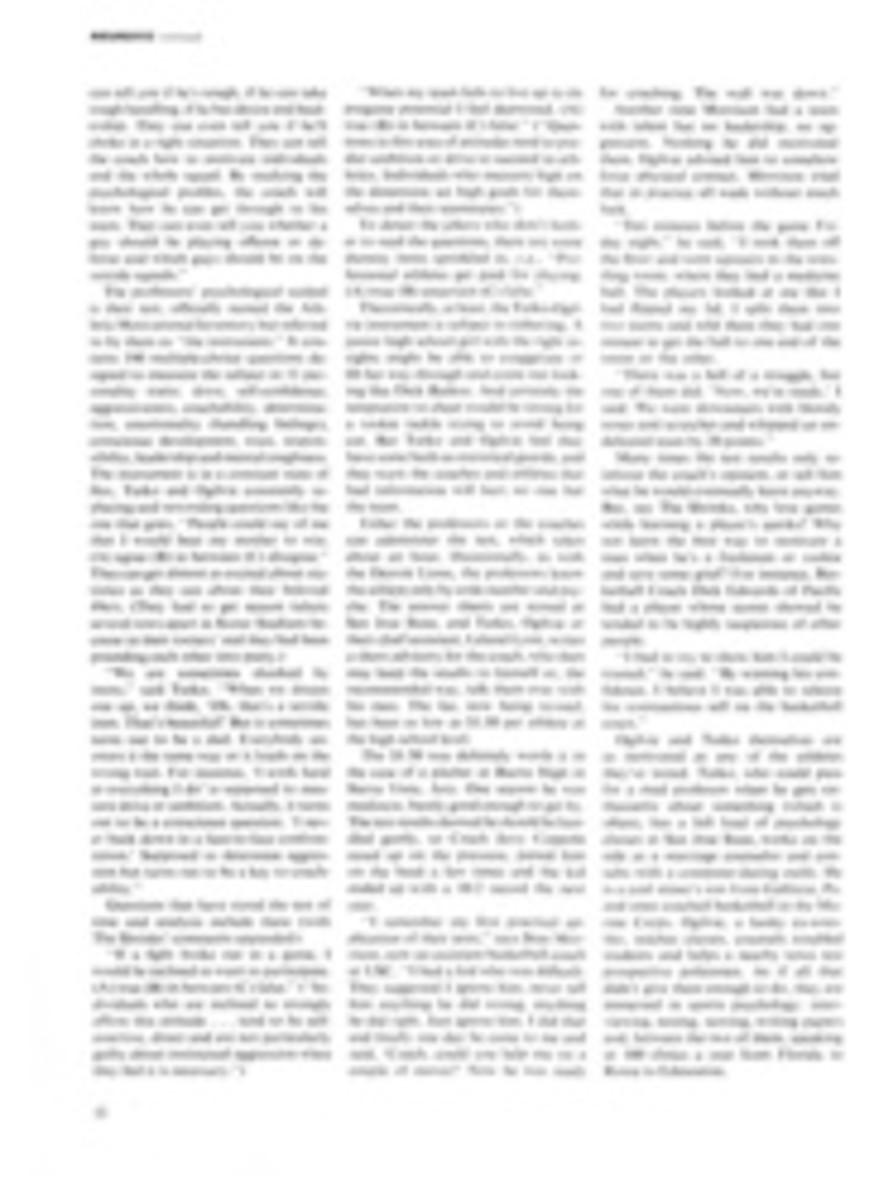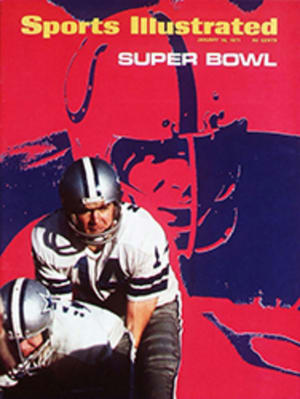
SCORECARD
GOING LIKE 60
While so much attention in pro basketball has been concentrated on the Spencer Haywood mess, a suggested modification of the game itself—which has just come to the serious interest of some NBA officials—deserves a bright spotlight. The idea is to lengthen the game from 48 minutes of four 12-minute quarters to 60 minutes of four 15-minute quarters. The proposal should be adopted by both leagues, since it is one of those rare propositions that is simple to effect and beneficial to all.
The move would give the fans 12 more minutes of action. An average game now runs well under two hours.
It would help management by producing greater concession and radio-TV revenues.
It would help the coaches, since they would have the opportunity to give all their players a chance to play regularly.
It would help the players for this same reason. Players would have a better chance to develop, a vital consideration now when there are more top players than ever before, and this year's college draft is touted as the best ever in terms of quantity.
But most important, a 60-minute game would help the sport of basketball. The great big men who dominate the game could not then keep up their present pace for 60 minutes. Depth and teamwork would count for more, and, without the one big man going the whole way, more variety and style would be introduced into every game.
ONE RUN FOR CHARLIE O
Some years ago Charles O. Finley, owner of the Oakland Athletics, proposed that the World Series be played at night. Now he has won one of his rare victories. Commissioner Bowie Kuhn has ruled that the fourth game of the 1971 Series will be televised in prime evening time unless the Chicago Cubs reach the Series—there are no lights in Wrigley Field.
NBC-TV, which currently televises baseball's Game of the Week, clearly has noted the success that ABC-TV has enjoyed with its Monday night pro football games. They boosted ABC's ratings some 50% over what they had been in 1969. And NBC also was quite happy with its own ratings for the nighttime 1970 All-Star game, which is supposed to have had 56 million viewers.
The swing to televising one Series game at night would indicate that if the experiment is successful in the ratings war against whatever the game's opposing attraction might be on the tube, eventually all Series games—except those played on Saturdays and Sundays—would be at night. Baseball is played better in daylight than under lights, of course, but the trend in sport today is to bend over backward for TV ratings.
It took years for Mr. Finley's night game idea to achieve fruition. Now we wonder about his newest. Finley's Oakland Athletics start their 1971 season at home with a questionable opening day program—a doubleheader. That's progress? Come on, you Cubs.
APRÈS DICHTER, WHAT?
A study of skiing and the psychological factors that make it attractive to so many has been undertaken by Dr. Ernest Dichter of the Institute for Motivational Research, which tells manufacturers how to put sex appeal into candy bars and automobiles. Among his findings:
"Women, as well as men, often have a feeling of potency, virility."
"In a sense, skiing is like a new religion. The après-ski sense of companionship and sociability is no accident and is caused by more than romantic fireplaces at ski lodges; the shared experience of people who date, the freedom of complete, satisfying accomplishment away from an alienating and mechanized modern world."
"Americans take the sport too seriously. In Europe it's just recreation. It's true today, even though skiing in Austria, where I was born, is a form of chauvinism. Austrians know that one of their major exports is ski instructors."
Dichter, at 63, has been invited to take a skiing course in Europe. And so he may take up this chauvinistic experience.
FANS ACROSS THE SEA
What promises to be the greatest transatlantic airlift of boxing fans in history is revving up its engines for the Muhammad Ali-Joe Frazier fight at Madison Square Garden March 8. Charter airlines are selling packages of fight tickets, passage and lodging, and having no trouble disposing of them. Says Norman Manches, manager of London's Dolphin Maritime and Aviation Services: "If I could get the fight tickets I probably could book 500 passengers." He has, in fact, 250 tickets ($50 seats for which he paid $65 each)—just enough for his chartered Super DC-8. Taberrer Travel Agency in Birmingham has already all but filled one Boeing 707.
Cost: £110, 15 shillings ($265.80) for two nights and three days in New York, to £125($300) for four nights, five days.
THE WISDOM OF YOGI
Business experts in Seattle are puzzled by the economic paradox suggested by the continuing success of the Seattle Super-Sonics in a city where the unemployment rate hovers between 10% and 12%, about twice the national average. The Sonics' 20-game home attendance total, 185,422, is almost 50,000 over last year's.
One reason could be that the Sonics are enjoying their best winning record so far. But it's easier to accept Yogi Berra's explanation of the ups and downs of attendance figures: "If the people don't want to come out to the park, nobody's gonna stop them."
GOOD DEED, NAUGHTY WORLD
If the James G. Blaine Society had its way, travel brochures describing the state of Oregon would read:
"Oregon—small, crowded, polluted. Freeways lousy. Economy failing. Crime rate and cost of living soaring. Natives hostile. State flower: poison ivy. State song: Raindrops Keep Fallin' on My Head."
All of which is a pack of lies, except that there really are some hostile natives—the Blaine Society—who would like to build barbed-wire fences along the state borders, keep tourists and industry out and let Oregon go its own lovely way.
The society was founded by the late Stewart Holbrook, author and historian, who chose Blaine as mythical leader for no better reason than that he is now an obscure figure and was dubbed The Plumed Knight at the 1876 Republican National Convention.
Holbrook mailed postcards around the U.S., claiming that the picture on them—showing a dirty steel mill pumping black smoke into the sky—was symbolic of Oregon industry. No matter that the steel mill depicted was in Pittsburgh. He also declared that tourists and newcomers should beware of the Atomic Energy Commission nuclear plant across the northeast border in Washington because it was emitting fumes that sterilized males.
When Holbrook died, a growing membership perpetuated his ideals, and now anyone can join who is dedicated to isolationism, badmouthing industrial development, and the credo that the enemy flag comes in the colors of an out-of-state license plate.
So help us, it is working. State residents now get precedence over outsiders in obtaining campsites at state parks. The state's travel advertising program has begun to lure tourists to commercial resorts. Public colleges are limiting out-of-state student enrollment to 15% (previously the University of Oregon's student enrollment was 30% Californian).
Holbrook's good was not interred with his bones.
ORDER OF DEMERIT
Walking to their hotel one day, Terry Driscoll and Terry Dischinger of the Detroit Pistons got to talking about the bad shots some basketball players take in games.
"You know," Driscoll explains. "Air balls [shots that don't hit the rim or backboard] and glass balls [shots that bounce off glass backboards like rockets]. Around the league they call them 'bricks' because the ball falls like a brick after one of these shots."
Dischinger noticed a brick—a real one—wrapped in tinfoil outside the hotel. And thus was born the Pistons' Silver Brick award. The team lost that night in Phoenix, and Bob Lanier got the brick "for overall bad play." A player who gets the seven-pound brick has to carry it with him wherever he goes until it is awarded to another player. Recipients are nominated by a committee of team members who did not play in the game—the DNP committee. They select two or three nominees, who are required to leave the locker room while the rest of the team makes a final choice. At the end of each month the player winning the award most times is honored with the Brick-of-the-Month award. As of now there is a three-way tie among leading recipients—Erwin Mueller, Lanier and Jimmy Walker, who have won it twice each.
Coach Bill van Breda Kolff has won it once. The Pistons lost one night in Philadelphia, and it was decided that he had ruined the team's momentum with substitutions he had made in the second half.
A FLYER IN CELLULOID
Working on road construction near Bel Air, Md. back in 1955, Harry Jackson found in a demolished old house what looked like a golf ball. On it was the date "1899" and the imprint "Kemps-hall Flyer." He tucked the ball away but, from time to time, wondered about it.
The sports department of Baltimore's Evening Sun recently advised him that the rubber golf ball was not invented until 1899. The U.S. Golf Association, through Bob Sommers, a public information officer who consulted a book, The Curious History of the Golf Ball, concluded that the ball was made of celluloid. Eleazer Kempshall, it turns out, was a Bostonian who made a fortune in celluloid, chiefly out of celluloid collars and eyelets for shoes.
"Apparently," reported Sommers, "he was a golf nut, too, and thought he could manufacture celluloid balls. He did, in fact, take out a patent on a celluloid ball in 1901, but the process never was satisfactory.
"He also made a gutta percha ball with a celluloid center and a celluloid ball with a gutta percha center. Try to figure that out.
"Anyway," Sommers concluded, "Mr. Kempshall was better known in the U.S. Patent Office than he was on the first tee."
ONE MORE FOR GUINNESS
For what it is worth, a new world marathon basketball record is claimed by Sarasota (Fla.) High School and Sarasota Riverview High. The two schools played from noon on Dec. 26 to 9 p.m. on Jan. 2, a total of 177 hours. Previous unofficial record: 150 hours, set last August by Gunners Basketball Association in Aurora, Ill.
Purpose of the game was to establish a better relationship between the two schools, its sponsors said, and wipe out the memory of a fistfight last season. Each team used 26 players and each player played three times a day in two-hour shifts. Final score: Riverview 9,216, Sarasota 8,980, no knockdowns.
ILLUSTRATION
THEY SAID IT
•Bill Fitch, coach of the hapless Cleveland Cavaliers: "Going into a game against Lew Alcindor is like going into a knife fight and finding there's no blade in your handle."
•Marv Harshman, Washington State University basketball coach: "If the Cougars have one outstanding trait this season, it's mediocrity."
•Billy Ray Smith, Baltimore Colt defensive tackle, asked if it is becoming harder to get to the quarterbacks because offensive linemen are bigger and better: "No, they're not getting any bigger or better. Their hands are getting better. They're holding, that's all. It's the reason passers are getting such good protection this year."
•John Brodie, asked why a million-dollar quarterback has to hold the ball for field goals and extra points: "Well, if I didn't, it would fall over."

